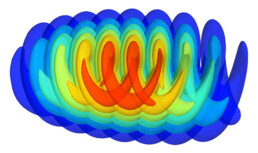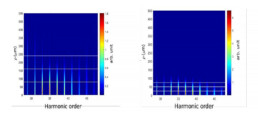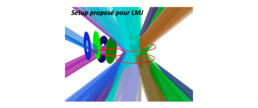Extreme regimes of light and matter
Coordinator : Emmanuel d’Humières (CELIA)
Experimental platforms benefiting from recent developments of high-intensity, high-energy lasers, has made it possible to produce :
- Structured light at high intensities,
- Brilliant and compact sources of particles and radiation,
- Extreme states of matter in the laboratory in terms of temperature, density, and very large electric and/or magnetic fields.
These developments are presently accompanied by the construction and commissioning of new large-scale facilities coupling different capacities: high power and high-energy lasers, production of extreme magnetic fields and bright X-ray beams all over the words. These technological breakthroughs will make it possible to reach new regimes of interaction of the matter and radiation, breaking with the current state of the art.
The major aim of this collaborative thrust is to develop Highly efficient miniaturized radiation and ion beam sources to drive matter to extreme states of interest for societal applications as well as laboratory astrophysics and inertial confinement fusion (ICF). This will consolidate the international leadership of UB in the fields of structured light, high energy radiation sources, laser plasma acceleration, high performance computing and high energy density physics.
This thrust revolves around four workpackages, Spatio-temporal topological shaping of light, which take advantage of these developments, and are based on common physical processes, as well as on the same experimental technologies and numerical simulation tools.
1. Spatio-temporal topological shaping of light and its applications
Controlling the topology of light fields emerged as a branch of modern photonics. To date, structured light has led to several major technological and conceptual achievements, for instance in optical imaging, optical processing of materials, optical information, optical trapping and optical micromanipulation.
High-intensity laser physics relies on the narrow focusing of ultrashort pulses with extended spectral widths, which is a major obstacle to achieving extreme intensity values for applications such as laser control of the relativistic motion of matter, or optical manipulation of matter on attosecond time scales and nanometer spatial scales.
Space-time couplings involving the orbital angular momentum (OAM) of ultrashort pulses may offer a way of overcoming this limitation. This WP addresses theoretically and experimentally the light-matter interaction in linear and non-linear materials with tailored ultra-high intensity OAM beams in order to develop the technology for the control of space-time coupling.
XPOL images of self-assembled packing of localized defect structures in a frustrated cholesteric film
2. Downscaling and optimizing bright ultrashort energetic photon sources
CUltra-short X-ray and extreme UV (XUV) beams, available in large research facilities such as XFEL, are essential for probing ultra-fast dynamics, 4D imaging (3D and time) at nanometric and femtosecond scales, on biological objects, electronics, structured surfaces. However, access to these facilities is very limited and the reproducibility of their XUV pulses remains problematic. By contrast, tabletop sources developed in laser laboratories are widely available and are better suited to interdisciplinary applications, provided their flows are optimized and controlled. Thanks to its state of the arts platforms (COLA, MALABO), the Bordeaux site is a key European player in these sources (European LaserLab network), endowed with internationally recognized know-how, with numerous studies carried out in attosecond XUV physics and X-ray absorption dynamics.
The overall objective of this WP is to develop “intelligent” learning approaches for laser-plasma interaction to optimize and sculpt bright XUV, X and gamma pulses, by playing on the spatio-temporal shaping of the laser pulse, and on the structuring of the target (solids and/or gas jet). Specific algorithms, based on traditional optimizations or by deep learning, must make it possible to achieve coherent diffraction imaging regimes with algorithms for phase reconstruction, imaging of structural protein dynamics, in situ imaging, nanostructuring …
Harmonic spectra in far field – K. Veyrinas et al. Opt. Express 29, 29813 (2021)
3. Miniaturization and optimization of a versatile laser-plasma driven ion accelerator and particle beam transport
Compared to conventional accelerators, laser-plasma acceleration devices are very versatile and can produce sources of energetic photons, neutrons, and heavier ions in various energy ranges.
Acceleration is performed in high electric fields, larger than hundreds of GV/m, reducing the acceleration length to a few millimetres. Moreover, shielding for radiation protection is not required in these acceleration setups. However, the existing experimental technologies have limited repetition rate and are not adapted to the new generation of high power, high repetition rate lasers.
This WP aims to produce optimized, high-repetition rate, laser-accelerated particle-beams with maximum energy and intensity, and minimum energy dispersion and divergence.
Particles such as ions, gamma rays and neutrons will be produced at high repetition (10 Hz) using novel targets e.g. gas jets thanks to a novel Petawatt laser that have been recently brought into operation.
Laser ion acceleration using gas jets – from experiments to simulations (PhD thesis of Pilar Puyuelo Valdes)
4. Light assisted magnetized plasma studies for laboratory astrophysics and inertial confinement fusion
The pursuit of environmentally acceptable energy sources has become critical. Controlled nuclear fusion is regarded as an endless supply of power with low environmental impact. Inertial confinement fusion is a promising approach, with more ignition-scale facilities (MJ-class lasers) coming online in France, China and Russia, and first experiments showing energy gain being performed on the National Ignition Facility (USA) in 2022 and 2023. Such facilities, in addition to fusion energy production, provide a unique access, at the laboratory scale, to the physics conditions relevant for many astrophysical objects.
This WP is devoted to explore laser-plasma processes operating in a magnetized high energy-density matter relevant for astrophysics (particle acceleration in collisionless shocks, magnetic reconnection…) and to study the physics in the context of novel magnetized ICF schemes. Our ambition is to strengthen the European leadership of the Bordeaux University in this domain of research, based on a long-term research effort and privileged access to unique high power, high energy laser facilities through well-established collaborations and MoUs (Omega at the University of Rochester, LMJ-PETAL at CEA-CESTA, CLPU-Vega-III in Spain and ELI-Beamlines in Czech Republic.).
LMJ beamtime in 2024 on magnetized high energy density physics(ALP) – PI: Joao Santos (CELIA, Univ. Bordeaux)
Teams
LP2IB
Selected Publications
Spin-orbit modal optical vortex beam shaping from dielectric metasurfaces
M. Jin, B. Sanchez-Padilla, X. Liu, Y. Tang, Z. Hu, K. Li, D. Coursault, G. Li, and E. Brasselet, Advanced Optical Materials, 2202149 (2022)
Quantum-Path-Resolved Attosecond High-Harmonic Spectroscopy
A. Camper, A. Ferré, V. Blanchet, D. Descamps, N. Lin, S. Petit, R. Lucchese, P. Salières, T. Ruchon, Y. Mairesse, Phys. Rev. Lett. 130, 083201 (2023)
Over-critical sharp-gradient plasma slab produced by the collision of laser-induced blast-waves in a gas jet ; Application to high-energy proton acceleration
J.-R. Marques, P. Loiseau, J. Bonvalet, M. Tarisien, E. d’Humieres, J. Domange, F. Hannachi, L. Lancia, O. Larroche, P. Nicolai, P. Puyuelo-Valdes, L. Romagnani, J. Santos, and V. Tikhonchuk Physics of Plasmas Vol.28, Issue 2 (2021)
W. Yao, A. Fazzini, S. N. Chen, K. Burdonov, P. Antici, J. Béard, S. Bolaños, A. Ciardi, R. Diab, E. D. Filippov, S. Kisyov, V. Lelasseux, M. Miceli, Q. Moreno, V. Nastasa, S. Orlando, S. Pikuz, D. C. Popescu, G. Revet, X. Ribeyre, E. d’Humières and J. Fuchs, Laboratory evidence for proton energization by collisionless shock surfing. Nat. Phys. 17, 1177–1182 (2021).
Exploring extreme magnetization phenomena in directly driven imploding cylindrical targets
C. A. Walsh, R. Florido, M. Bailly-Grandvaux, F. Suzuki-Vidal, J. P. Chittenden, A. J. Crilly, M. A. Gigosos, R. C. Mancini, G. Pérez-Callejo, C. Vlachos, C. McGuffey, F. N. Beg and J. J. Santos et al., Plasma Phys. Control. Fusion 64 025007 (2022)




